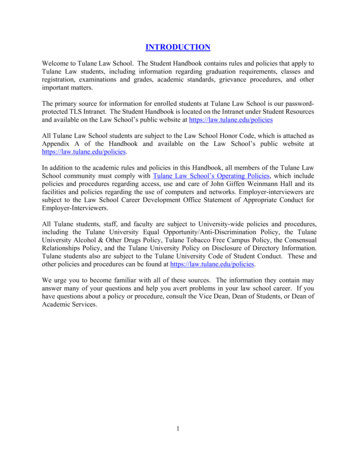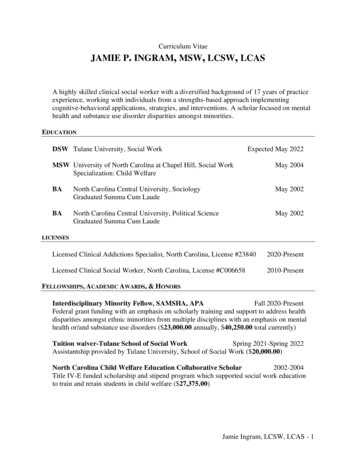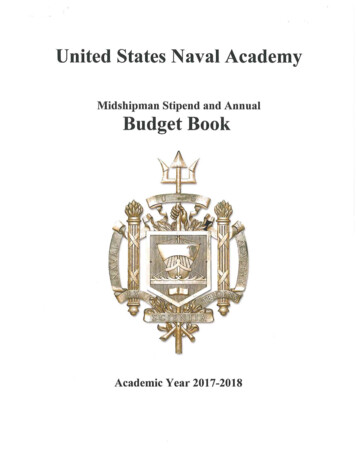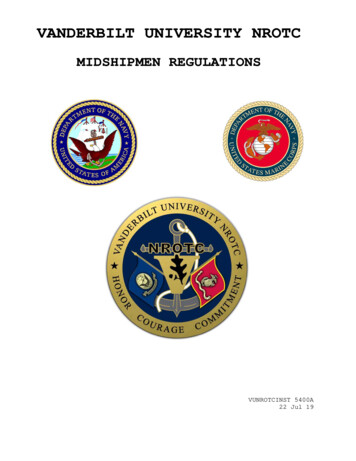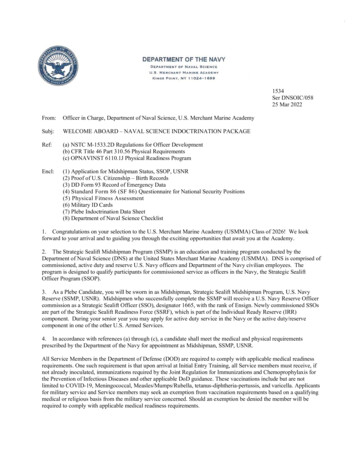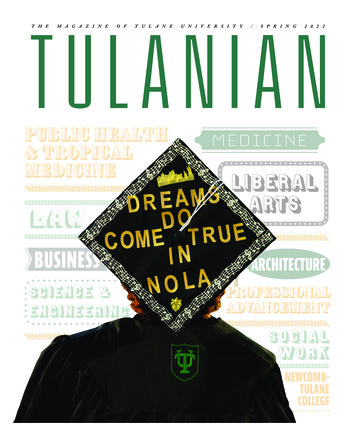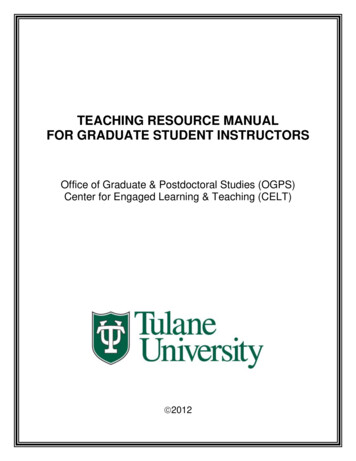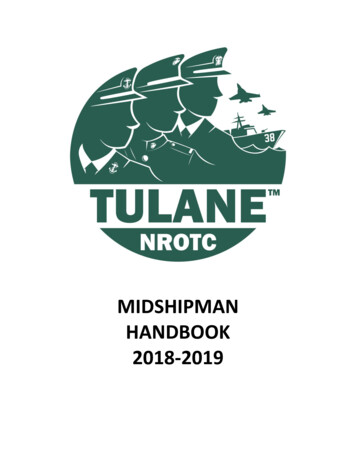
Transcription
MIDSHIPMANHANDBOOK2018-2019
153301 Aug 18From:To:Commanding Officer, NROTC Unit, TulaneUniversityTulane University MidshipmenSubj:MIDSHIPMAN HANDBOOKRef:(a) NSTCINST M-1533.2C (Regulations for OfficerDevelopment)(b) NSTCINST 5370.1B(c) NAVPERS 15665I1. Purpose. The purpose of this handbook is toemphasize and clarify regulations within references (a)through (c) that outline standards of personal conductexpected of midshipmen of Tulane University NavalReserve Officers Training Corps (NROTC). This handbookalso provides midshipmen with general guidance forconducting certain routine battalion operations. Thishandbook is not inclusive, and does not obviatemidshipmen from compliance with regulations outlined inrefs (a) through (c).2. Cancellation. This publication cancels all previouseditions of the handbook. All Battalion Orders andNROTC Unit Instructions remain valid.3. Applicability. These regulations apply to allTulane University NROTC students, regardless of whichspecific university the student attends. The terms“Midshipman” and “NROTC student” apply to Scholarship,College Program, MECEP and OC students. This documentalso covers subjects and activities that personneladministratively attached to the command are required toobserve.i
4.Actiona. Read and understand the provisions of thishandbook. Be aware of all changes to the handbook;changes will be highlighted on electronic versions ofthis document throughout the year. Changes will also bemade via Battalion Notices.b.Comply with the contents of this handbook.c. Return all printed/bound versions of thishandbook to the Marine Officer Instructor via theMidshipman Logistics Officer if disenrolled from theunit.P. N. HueteCaptain, U.S. Navyii
TABLE OF CONTENTSCHAPTER 1 COMMAND PHILOSOPHY . 1CHAPTER 2 PERSONAL CONDUCT . 41.2.3.4.5.6.7.HONOR CODE.4ALCOHOL. 4DRUGS.5SEXUAL CONDUCT.6FRATERNIZATION.7SOCIAL EXPECTATIONS AND RESPONSIBILITIES.PERFORMANCE REVIEW BOARDS. 99CHAPTER 3 PERSONAL APPEARANCE . 111.2.3.5.6.PHYSICAL FITNESS STANDARDS.11GROOMING.11CIVILIAN DRESS CODE STANDARDS. 18BODY ORNAMENTATION.22UNIFORM OF THE DAY.22CHAPTER 4 CUSTOMS, COURTESIES, AND ETIQUETTE . 231.2.3.4.MILITARY COURTESY.23ADDRESSING MILITARY PERSONNEL. 24MILITARY CORRESPONDENCE.24NAVY BUILDING.24CHAPTER 5 NAVY/MARINE CORPS KNOWLEDGE . 27APPENDICES . APPENDIX47APPENDIXABCDEFGALCOHOL USE AND ABUSE37ACADEMIC STANDARDS MEMORANDUM40PHYSICAL FITNESS STANDARDS MEMORANDUM42USMC HEIGHT AND WEIGHT STANDARDS (MALE/FEMALE)44USN HEIGHT AND WEIGHT STANDARDS (MALE/FEMALE)45IMPORTANT PHONE NUMBERS 46COMMANDER’S CRITICAL INFORMATION REQUIREMENTS (CCIRS)H MIDSHIPMEN ROLES AND EXPECTATIONSiii50
CHAPTER 1COMMAND PHILOSOPHY“Our charge is to develop midshipmen morally, mentally,and physically.”1. Our command philosophy, simply put, is Service BeforeSelf. You are now part of something greater thanyourself. You now share in the legacy of the Navy andMarine Corps, handed down since 1775 - you are poised towrite the next chapter in our illustrious story. We arepart of a team, a special team with its own legacyhanded down since 1938. Your journey here will developyou as a leader, ethically sound, disciplined,possessing integrity and moral character. Concurrently,your journey will inculcate in you, a sense of sacrificeand service to the nation, your command, and each other.Your actions make a difference – this is your command.2. The Navy and Marine Corps core values of Honor,Courage, and Commitment will guide us in our journey.They are not buzzwords; rather, they are the foundationof our service. The following traditional principles,time-tested, proven, and supported by our shared corevalues will govern our conduct in our command and ensureour success:a. Mission Accomplishment.This is what we areall about. Your primary missions as midshipmen:Academic Excellence. Leadership Development. PhysicalReadiness. Know your mission and what it takes to getit done. Do it, and then celebrate it. The staff existsto help you succeed.b. Professionalism. Ours is the profession ofarms, and it is unyielding. We expect of and receive1
from each other the highest levels of professionalismand courtesy. Our pride in our command and ourselves isjustified by our performance and our professionalism.Plan. Execute. Lead. Take ownership of your efforts you are accountable for your actions.c. Citizenship. Respect for the laws and customsof our society helps reinforce our place in it. Respectuniversity authorities as you do civilian and military.Strive for the balance required to uphold your oath tothe Constitution and your obligations to your family andcommunity. Tulane NROTC will be an active member of anda positive influence on the Tulane and New Orleanscommunities. We will be good neighbors.d. Shipmate. You are an American, and you are amidshipman. But first, you are a human being. As such,you deserve dignity and respect. Protect yourintegrity, and respect the dignity of others. Be a goodshipmate – take care of each other.e. The Unit. We have obligations to each otherthat transcend the interpersonal relationships that markour being part of any other organization. Each of us isa steward of this bond, and it is our duty to extend itto each new member of our unit. Foster a sense ofloyalty and dedication not only to the service of ournation, but to each other. Take pride in our team –this is your unit, this is your building, these are yourshipmates.f. Relentless Excellence. Relentless Excellence inall we do. Apply these two words to everything you doin this command, every time you do it. Don't give up.Don't accept mediocrity. Accept nothing less fromyourself and your shipmates, and Tulane NROTC will leadthe way.2
3. Our command will continue to be shaped by highstandards, ethical behavior, sacrifice, and stewardship.The great history and purpose of our Nation, themagnificent story and traditions of our Navy and MarineCorps, the pride and expectations of our fellowcountrymen and our responsibility to them will be thestrong undercurrent that will daily remind us of ourobligations. By freely choosing a path to serve yourcountry, you have chosen a life of consequence. ServiceBefore Self.3
CHAPTER 2PERSONAL CONDUCT1. HONOR CODE. A midshipman does not lie, cheat orsteal. Midshipmen are persons of integrity: They standfor that which is right. They tell the truth and ensurethat the full truth is known. They do not lie. Theyembrace fairness in all actions. They ensure that worksubmitted as their own is their own, and that assistancereceived from any source is authorized and properlydocumented. They do not cheat. They respect theproperty of others and ensure that others are able tobenefit from the use of their own property. They do notsteal.2.ALCOHOL.a. Underage Drinking. State law prohibits anyperson under the age of 21 to consume, purchase, orpossess alcohol. Use of a fake, forged, or doctored IDis also illegal. Use of a fake, forged, or doctored ID,to purchase alcohol or for any other purpose, isconsidered a falsehood. This act will be consideredhonor code violation, and may be grounds fordisciplinary action and/or program disenrollment.b. Drinking and Driving. DO NOT DRINK AND DRIVE!DWI and DUI offenses are not tolerated in the Navy orMarine Corps and will not be tolerated at Tulane NROTC.c. Responsible Use. Refer to Appendix A for thecommand policy on alcohol consumption.d. Although underage students 18 years and olderare allowed to enter establishments that serve alcohol,some establishments near campus, including Greekorganizations, have been known to provide alcohol to4
students under the age of 21 and have been linked toalcohol related incidents. Midshipmen under 21 arestrongly discouraged from frequenting theseestablishments.3.DRUGS.a. Military Policy. The military has a "zerotolerance" policy on drugs. No exceptions. It isunlawful for persons in the Department of the Navy (DON)to use controlled substance analogues (designer drugs),natural substances (e.g., fungi, excretions), chemicals(e.g., chemicals wrongfully used as inhalants),propellants, synthetic compounds not for human use,spice/bath salts, and/or a prescribed or over-thecounter (OTC) drug or pharmaceutical compounds, with theintent to induce intoxication, excitement, orstupefaction of the central nervous system. Use ofthese substances is prohibited and will result inadministrative and disciplinary action.b. Urinalysis. Urinalysis testing will be conductedrandomly throughout each school term. Both prescriptionand OTC drugs must be documented during each urinalysissession. Prescription drugs must be prescribed by alicensed physician and used according to prescribeddosages. The use of drugs such as Adderall without aprescription is the same as abusing an illegal drug, asdescribed in paragraph 3.a.c. There are establishments near campus that fosterand perpetuate the use of illegal substances and selldrug use paraphernalia. Midshipmen are stronglydiscouraged from frequenting these establishments.5
4.SEXUAL CONDUCT.a. Sexual Harassment. Sexual harassment is a formof gender discrimination that involves unwelcome sexualadvances, requests for sexual favors and other verbalconduct of a sexual nature. Sexual harassment violatesstandards of behavior required of all Department of Navypersonnel. It is unacceptable conduct; it debilitatesmorale, interferes with the work productivity of anorganization and can cause serious psychological stressfor the recipient. It is the responsibility of everymember of the U.S. Navy and Marine Corps to ensure thatsexual harassment is prevented and that any instance ofsexual harassment is dealt with swiftly, fairly, andeffectively. Sexual harassment will not be tolerated inTulane’s NROTC Unit. Reference your training or consultwith your advisor to become familiar with appropriateaction in response to such an incident.b. The Navy and Marine Corps commit themselves toforging strong teams built on the strengths of ourSailors and Marines. Sexual harassment and, even worse,sexual assault threaten the strength of our team. TheNaval Services focus on eliminating sexual assaultthrough the Sexual Assault Prevention and Response(SAPR) program. Midshipmen will participate in at leastannual SAPR training coordinated by the unit staff. Thistraining is designed to bring awareness and sensitivityto the problem, help service members understand theimportance of bystander intervention, and create an openchain of communication. Tulane NROTC strictly supportsand adheres to the standards and policies established bySAPR. Should an incident occur, the victim shouldreport it directly to a university official, lawenforcement, academic advisor, or any unit staff member.6
c. Summer Cruise. Sexual relations between amidshipman and any U.S. military member during summercruise are prohibited by the Uniform Code of MilitaryJustice (UCMJ) and will be prosecuted accordingly.5.FRATERNIZATION.a. Personal relationships between officer andenlisted personnel, between staff members andmidshipmen, and among midshipmen that are undulyfamiliar and do not respect differences in rank andgrade are prohibited and violate long-standing customsand traditions of the Naval Service. Relationshipsthat are sexual, intimate, or romantic betweenmidshipmen of different classes may also be prejudicialto good order and discipline or of a nature to bringdiscredit on the U.S. Navy may also be prohibited.b. Examples of conduct that are unduly familiarincludes, but is not limited to:(1) Developing or attempting to developpersonal, intimate, sexual relations, or romantic,including dating, handholding, kissing, caressing, orengaging in sexual activities;(2) Attempting, arranging, or engaging inpersonal engagements that typically lead to sexual, orromantic relationships;(3) Engaging in private business or financialrelationships;(4) Any non-professional social relationship ora personal nature;(5)Gambling or borrowing money.7
c. Actions that are prejudicial to good order anddiscipline or bring discredit to the Naval Serviceinclude, but is not limited to circumstances or conductwhich:(1) Call into question the senior’sobjectivity;(2)treatment;d.Results in actual or apparent preferential(3)Undermines the authority of the senior;(4)Compromises the chain of command.Prohibited Relationships.(1) Relationships or behavior betweenmidshipmen are inappropriate if the relationship orbehavior takes advantage or gives the impression thatadvantage is being taken of a vulnerability, weakness orstatus, or results in harassment of another midshipmen.Such behavior includes, but is not limited to dating;intimate or sexual contact; contact via cards, letters,e-mails, telephone calls, instant messaging, video,photographs, social networking, or any other means ofcommunication.(2) While dating among midshipmen is stronglydiscouraged, a personal relationship between midshipmenis not necessarily considered fraternization.Relationships between midshipmen within a direct chainof command give the appearance of impropriety and shallbe avoided. In cases where such relationships cannot beavoided, the midshipmen involved shall bring therelationship to the attention of the unit active duty8
staff. One or both midshipmen may be reassigned todifferent billets within the battalion.(3) Unduly familiar relationships betweenmidshipmen and Marine Enlisted Commissioning EducationProgram students (MECEPs) or Navy Officer Candidates(OC) or STA-21 students are prohibited.(4) Unduly familiar relationships betweenmidshipmen and all active duty personnel is prohibited.e. Violations will result in disciplinary actionagainst both individuals involved in the relationship.Marriage subsequent to fraternization neither excusesnor mitigates the original misconduct.f. Exceptions or uncommon circumstances are listedin ref (b).6. SOCIAL EXPECTATIONS AND RESPONSIBILITIES.Extracurricular Activities. Participation inextracurricular activities afforded to college studentscontribute to that student’s development and aregenerally encouraged. NROTC events, however, shall takeprecedence over extracurricular activities. Any requestfor exception to this policy will be considered on acase-by-case basis and must be approved in advance bythe class advisor. Midshipmen should realize that theseactivities may distract, impede or interfere with themachieving their ultimate goal of graduation andcommissioning. Participation in extracurricularactivities, including employment, shall be discussedwith the midshipman’s class advisor.7.PERFORMANCE REVIEW BOARDS.9
a. A Performance Review Board (PRB) is anadministrative action the NROTC staff uses to assessperformance of a midshipman. This process isadministered to facilitate the midshipman’s growth if heor she currently struggles to overcome personalobstacles or any other situations that threaten themidshipman’s performance.b. The primary focus of a PRB is to redirectmidshipmen; however, administrative action is sometimestaken to supplement the counseling provided by the PRB.These administrative actions, in order of severity,include a letter of warning, probation, leave of absence(LOA), or disenrollment from the program. The PRB mayalso prescribe “no action” if it believes noadministrative action is required for the situation.Administrative action will likely be taken for thefollowing reasons:(1)Substandard academic performance(2)Offenses that indicate moral turpitude(3)A serious breach of discipline(4)authorityA hardened disregard or contempt for(5)An incorrigible lack of energy and purpose(6)A culpable lack of sense of responsibility(7)Actions that bring discredit upon the NavalServiceIf a PRB will be held, the midshipman will be notifiedby letter from the PNS. Within five business daysfollowing the PRB, the midshipman will receive a record10
of the proceedings, including a recommendation ofappropriate course of action from the Senior Member ofthe PRB to the PNS.CHAPTER 3PERSONAL APPEARANCE1. PHYSICAL FITNESS STANDARDS. Refer to Appendix C forPhysical Fitness Standards for NROTC and this unit.Refer to Appendix D for tables outlining genderspecific, Marine option minimum/maximum weights forgiven heights. Refer to Appendix E for tables outlininggender-specific, Navy option maximum weights for givenheights. Midshipmen who fail to meet height and weightstandards will be subject to a body composition test inorder to identify body fat percentages.2. GROOMING.a. General. Grooming standards are based onneatness, cleanliness, safety, military image andappearance. The standards established are notexcessively restrictive nor designed to isolate militarypersonnel from society. The limits set forth arereasonable, enforceable, and ensure that personalappearance contributes to a favorable military image.The differences between male and female groomingpolicies recognize the differences between genders.Establishing identical grooming and personal appearancestandards for men and women would not be in the NROTCunit's best interest and is not a factor in theassurance of equal opportunity. The primaryconsideration is to have a neatly-groomed, highlyprofessional appearance at all times- in and out ofuniform.11
b.Males.(1) Hair. Keep hair neat, clean and wellgroomed. Hair above the ears and around the neck shallbe tapered from the lower natural hairline upwards atleast 3/4 inch and outward not greater than 3/4 inch toblend with hairstyle. Hair on the back of the neck mustnot touch the collar. Hair shall be no longer than fourinches and may not touch the ears, collar, extend beloweyebrows when headgear is removed, show under front edgeof headgear, or interfere with properly wearing militaryheadgear. The bulk of the hair shall not exceedapproximately two inches. Bulk is defined as thedistance that the mass of hair protrudes from thescalp. Hair coloring must look natural and complementthe individual. Faddish styles and outrageousmulticolored hair are not authorized. The uniquequality and texture of curled, waved, and straight hairare recognized, and in some cases the 3/4 inch taper atthe back of the neck may be difficult to attain. Inthose cases hair must present a graduated appearance andmay combine the taper with a line at the back of theneck. One (cut, clipped or shaved) natural, narrow, foreand aft part is authorized. Varying hairstyles,including afro, are permitted if these styles meet thecriteria of maximum length and bulk, tapered neck andsides, and do not interfere with properly wearingmilitary headgear.(2) Sideburns. Sideburns do not extend belowthe middle of the ear, are even width (not flared) andend with a clean shaven horizontal line.(3) Facial Hair. The face shall be cleanshaven when in uniform and shall be clean-shavenwhenever a midshipman enters the Navy building.Mustaches and any other form of facial hair are notauthorized for midshipmen.12
(4) Fingernails. Male fingernails should beclean and not extend past the fingertips.(5) Jewelry. Jewelry presenting a safety orForeign Object Damage (FOD) hazard is not authorized.Jewelry must fall within the following guidelines:(6) Rings. While in uniform, only one ring perhand is authorized, plus a wedding/engagement set. Ringsare not authorized for wear on thumbs.(7) Earrings/Piercings. Earrings and piercingsof any kind are not authorized on campus, whether in orout of uniform. Earrings are prohibited in civilianattire when in a duty status or while in/aboard anyship, craft, aircraft, or in any military vehicle, orwithin any base or other place under militaryjurisdiction or while participating in any organizedmilitary recreational activities. One earring isauthorized off campus.(8) Necklaces/Chokers. While in uniform,midshipmen may wear only one necklace. However, thenecklace must not be visible. Necklaces are notauthorized during PT.(9) Wristwatches/Bracelets. While in uniform,these shall be conservative and in good taste.Eccentric or faddish wristwatches and bracelets are notauthorized. Only one watch and one bracelet may be wornsimultaneously (one on each wrist) while inuniform. Ankle bracelets are not authorized while inuniform.c.Females13
(1) Acceptable Hairstyle Criteria. Hairstylesand haircuts shall present a professional and balancedappearance. Appropriateness of a hairstyle shall beevaluated by its appearance when headgear is worn. Allheadgear shall fit snugly and comfortably around thelargest part of the head without distortion or excessivegaps. Hairstyles will not interfere with the properwearing of headgear, protective masks or equipment. Whenheadgear is worn, hair shall not show from under thefront of the headgear. Hair may protrude from theopening in the back of the ball cap. Lopsided andextremely asymmetrical hairstyles are not authorized.Angled hairstyles will have no more than a 1-1/2 inchdifference between the front and the back length ofhair. Layered hairstyles are authorized provided layerspresent a smooth and graduated appearance. Hair length,when in uniform, may touch, but not fall below ahorizontal line level with the lower edge of the back ofthe collar. With jumper uniforms, hair may extend amaximum of 1-1/2 inches below the top of the jumpercollar. Long hair, including braids, shall be neatlyfastened, pinned, or secured to the head. When bangs areworn, they shall not extend below the eyebrows. Hairlength shall be sufficient to prevent the scalp frombeing readily visible. Hair bulk (minus the bun) asmeasured from the scalp will not exceed 2 inches. Thebulk of the bun shall not exceed 3 inches when measuredfrom the scalp and the diameter of the bun will notexceed the width of the back of the head. Loose endsmust be tucked in and secured. Hairstyles shall notdetract from a professional appearance in uniform.Styles with shaved portions of the scalp (other than theneckline), those with designs cut, braided, or partedinto the hair, as well as dyed using unnatural colorsare not authorized. The unique quality and texture ofcurled, waved and straight hair are recognized. Allhairstyles must minimize scalp exposure. While this list14
shall not be considered all inclusive, the followinghairstyles are authorized:(a) Three strand braids and two strandbraids (also referred to as twists). Braided hairstylesshall be conservative and conform to the guidelineslisted herein.(b) Multiple braids. Multiple braidsconsist of more than two braids and encompass the wholehead. When a hairstyle of multiple braids is worn, eachbraid shall be of uniform dimension, small in diameter(no more than 1/4 inch), and tightly interwoven topresent a neat, professional, well-groomed appearance.Foreign material (e.g., beads, decorative items) shallnot be braided into the hair. Multiple braids may beworn loose, or may be pulled straight back into a bun,within the guidelines herein.(c) Two individual braids. One braid wornon each side of the head, uniform in dimension and nomore than one inch in diameter. Each braid extends fromthe front to back of the head near the lower portion ofthe hair line (i.e., braids are closer to the top of theear than the top of the head to prevent interferencewith wearing of headgear). A single French braid may beworn starting near the top of the head and be braided tothe end of the hair. The end of the braid must besecured to the head and braid placement shall be downthe middle of the back of the head.(d) Corn rows. Must be in symmetrical foreand aft rows, and must be close to the head, leaving nohair unbraided. They must be no larger than 1/4 inch indiameter and show no more than approximately 1/8 inch ofscalp between rows. Corn row ends shall not protrudefrom the head. Rows must end at the nape of the neck andshall be secured with rubber bands that match the color15
of the hair. Corn rows may end in a bun conforming tothe guidelines listed herein, if hair length permits.(e) Rolls. Two individual rolls, one oneach side of the head, must be near the lower portion ofthe hair line (i.e., rolls are closer to the top of theear than the top of the head and will not interfere withwearing of headgear). Rolls must be of uniformdimension and no more than one inch in diameter.(2) Hair Accessories. When hair accessories areworn, they must be consistent with the hair color. Amaximum of two small barrettes, similar to hair color,may be used to secure the hair to the head. Bunaccessories (used to form the bun), are authorized ifcompletely concealed. Additional hairpins, bobby pins,small rubber bands, or small thin fabric elastic bandsmay be used to hold hair in place, if necessary. Theintent is for pinned-up hair to be styled in a mannerthat prevents loose ends from extending upward oroutward from the head. For example, when using barrettesor hairpins, hair will not extend loosely from the head;when hair is in a bun, all loose ends must be tucked inand secured. Headbands, scrunchies, combs, claws andbutterfly clips are examples of accessories that are notauthorized.(3) Grooming Standards Exception. Ponytails areauthorized during physical training. Hair restrainingdevices, if worn, will be consistent with the currenthair color.(4) Cosmetics. Use cosmetics that blend withnatural skin tone and enhance natural features. Do notwear exaggerated or faddish cosmetic styles withuniforms. Avoid an artificial appearance. Useconservative lipstick colors that complement the16
individual.uniform.Do not wear long, false eyelashes while in(5) Fingernails. Fingernails should not exceed1/4" beyond the fingertip. Use nail polish colors thatcomplement skin tone. French and American manicures(white and off-white tips with neutral base color ONLY)are authorized.(6) Female Jewelry. Females may wear jewelry.Eccentricities or faddishness are not permitted. Jewelrypresenting a safety or FOD hazard is prohibited. Use thefollowing guidelines for jewelry:(a) Rings. While in uniform, only one ringper hand is authorized, plus a wedding/engagement set.Rings are not authorized for wear on thumbs.(b) Earrings/Piercings. Only one earringper ear with any uniform is authorized. Earrings shouldbe 1/8-l/4", ball shaped, plain with brushed mattefinish and may be screw-on or use posts. Officers, chiefpetty officers and midshipmen wear gold and enlistedpersonnel wear silver. Wearing round, 1/8-1/4” whitepearl earrings or 4mm-6mm round cut diamond earrings isauthorized with dress uniforms. Body piercings otherthan of the ears are not authorized while in uniform.No articles, other than earrings for women specifiedabove, shall be attached to or through the ear, nose, orany other body part.(c) Necklaces/Chokers. While in uniform,midshipmen may wear only one necklace. However, thenecklace must not be visible. Necklaces are notauthorized during PT.(d) Wristwatch/Bracelets. While in uniform,these shall be conservative and in good taste.17
Eccentric or faddish wristwatches and bracelets are notauthorized. Only one watch and one bracelet may be wornsimultaneously (one on each wrist) while inuniform. Ankle bracelets are not authorized while inuniform.3. CIVILIAN DRESS CODE STANDARDS.Campus and Around the City. Midshipmen will be expectedto abide by the dress-code guidelines below when not inuniform.a.Males(1) Legwear. Shorts and trousers must be neatlyhemmed. Boxers will not extend beyond the hem of theshorts. Garments with belt loops should be worn withbelts.(2) Buttoned Shirts. Shirts with buttons shouldbe buttoned at all times.(3) Shirt Tucking. Collared shirts and t-shirtsdo not have to be tucked into trousers but should appearclean and non-wrinkled.(4) Footwear. Shoes must be appropriate. Wearsocks with shoes (except deck shoes, loafers andsandals) and tie shoes if they have laces.(5) Undergarments. Undergarments should not beexposed in any way. Clothing with slogans, symbols,language or graphics that are obscene or offensive inany way are not authorized.(6) Exceptions. Wear appropriate attire for theoccasion. For example, crawfish boils and intramuralsports require attire not suitable for everyday wear.Use good judgment.18
b.Females(1) Leg wear. Dresses, skirts and shorts shouldnot be excessively short.(2) Tank Tops. Tank tops are authorized if theyare not excessively low cut.(3) Midriff Tops. Midriff tops (i.e. tops thatbare the stomach) are only authorized for non-unitsponsored physical fitness training.(4) Piercings. Body piercing is not authorizedin civilian attire when in a duty status or whilein/aboard any ship, craft, aircraft, or in any militaryvehicle or within any base or other place under militaryjurisdiction, or while participating in any organizedmilitary recreational activities.(5) Undergarments. Undergarments should not beexposed in any way.c. General. Civilian dress should be in good taste.You are representing the Naval Service. Style ispossible without discrediting yourself and the NROTCunit. Use common sense!d.Common Dress Standards(1) Semi-formal. For males, the outfit includesa sport coat and tie. For females, the outfit includes aconservative dress, slacks, or pant suit.(2) Proper Civilian. For males, this includespolo-style shirts or button-down collared shirts, slackswith belt loops, a belt and presentable shoes. Forfemales, the outfit includes slacks, skirts or dresses19
with blouses of equal appearance and quality, shortheels, loafers or dress sandals/slippers.(3) Appropriate Civilian. This term is used todescribe clothing that should be in good taste,comfortable and presentable and is suitable for theevent at hand. Jeans, non-athletic shorts, jean shortswith hems, shorts with belt loops, quality skirts(females) that are similarly worn with collared shirtsor t-shirts that do not display racist, sexist orotherwise immoral/unet
a. Underage Drinking. State law prohibits any person under the age of 21 to consume, purchase, or possess alcohol. Use of a fake, forged, or doctored ID is also illegal. Use of a fake, forged, or doctored ID, to purchase alcohol or for any other purpose, is considered a falsehood. This act will be considered honor code violation, and may be .
